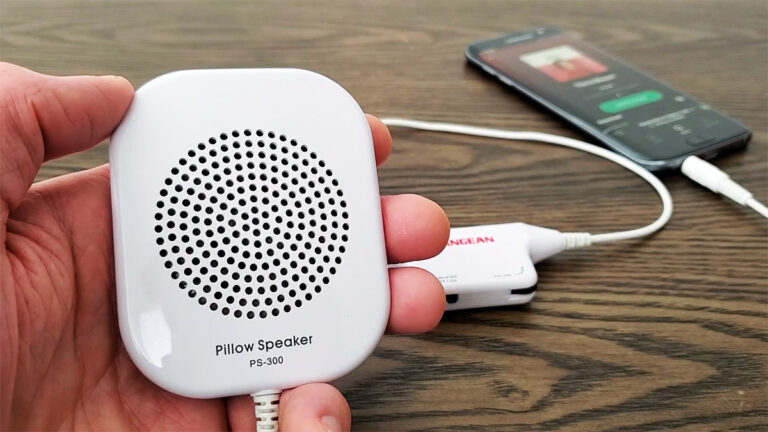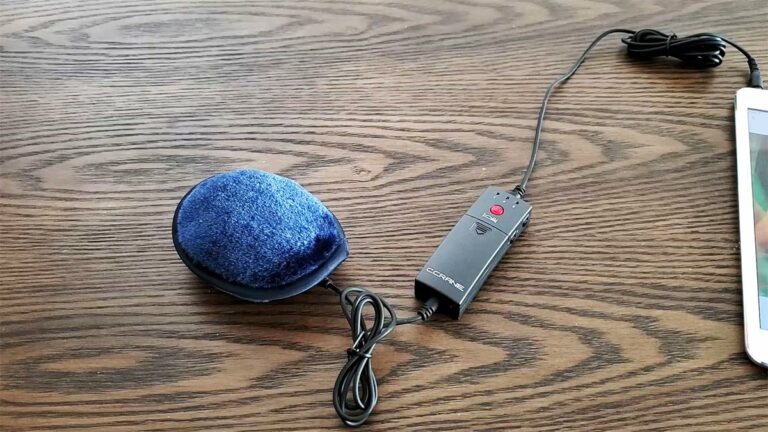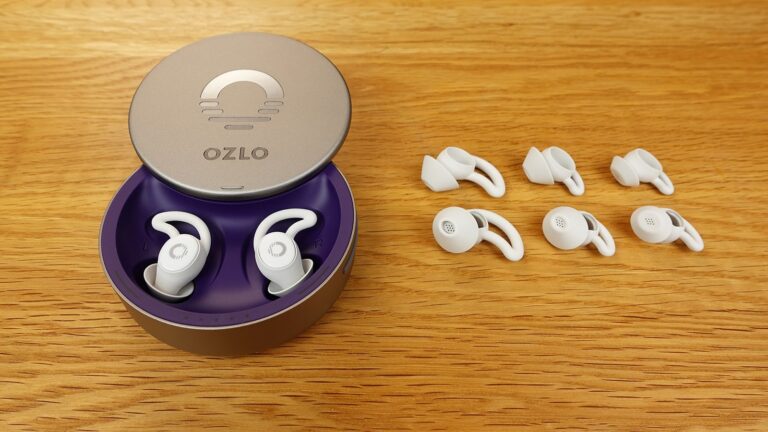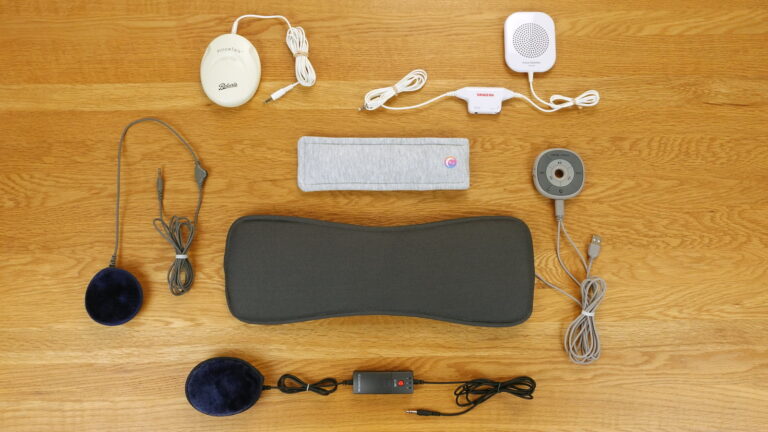Disclosure: My website is reader supported. If you choose to buy a product after clicking a link, I may earn a commission, at no extra cost to you. Learn more.
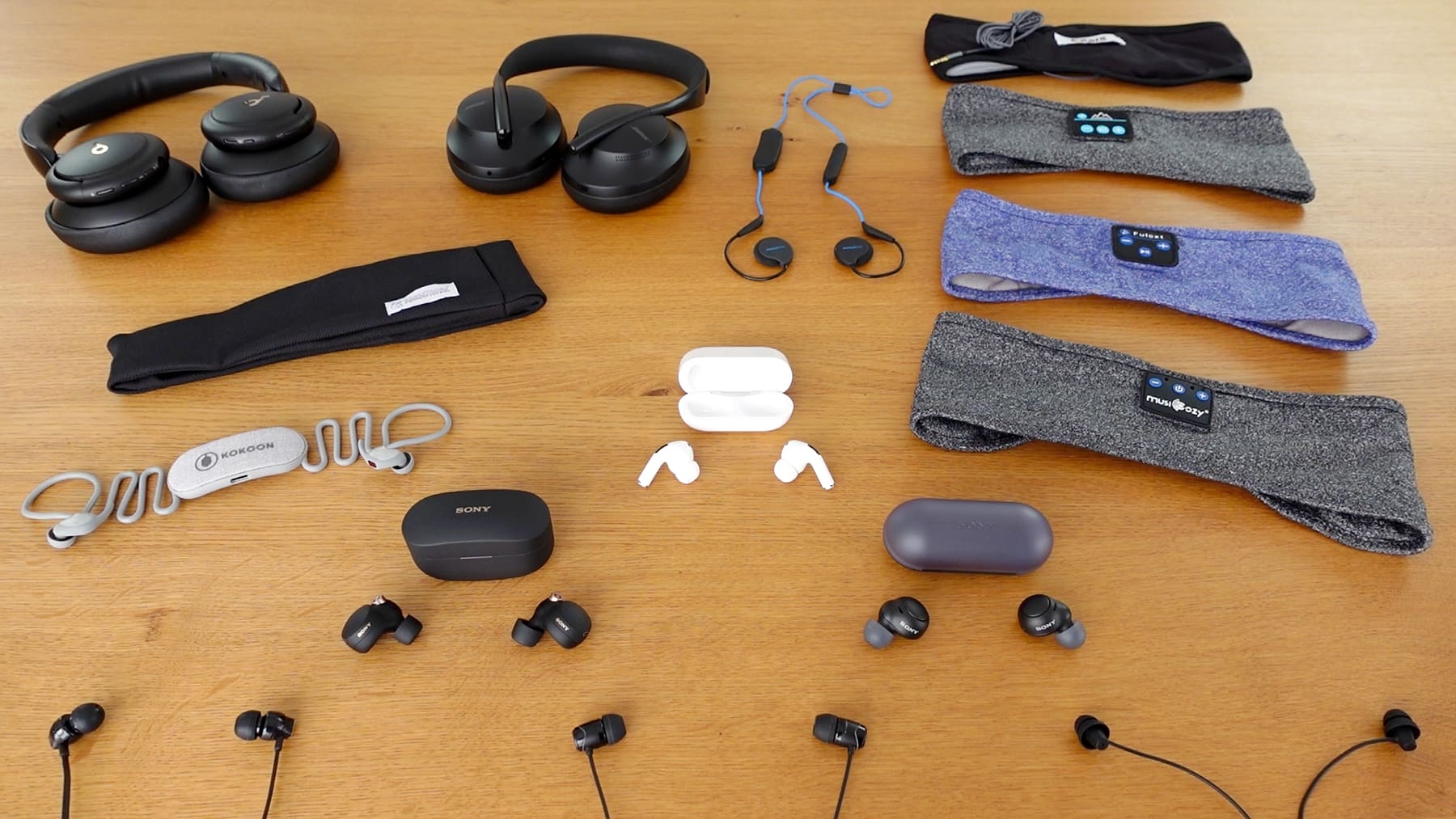
In the photo above, you can see the headphones I tested and will be discussing in this article. Note how there are several styles to consider: Bluetooth earbuds, wired earbuds, over-ear, on-ear, and headbands.
As much as silence can be golden at night, sometimes listening to music in bed is the perfect way to drop down a few gears and wash off the mental dust at the end of a long day.
As well as enjoying your own music, headphones can also help if your neighbor’s music or your partner’s snoring creates audio earthquakes in your bed.
The thing is, not all headphones are comfortable to wear in bed for long periods of time, especially if you sleep on your side or front. So it’s important to choose headphones that strike the right balance between comfort, audio quality, and noise cancellation (if you need that).
In this review, I’ll be looking at some dedicated sleep headphones, including the flat headband style and those with tiny earbuds. I’ve also included my favorite noise-cancelling headphones for those who really want to shut the world out at night.
Please note that all of the photos are my own and the exact headphones I tested, but the manufacturers may make changes to them in the future.
Contents
Overview of the headphones
Apple Airpods Pro 2
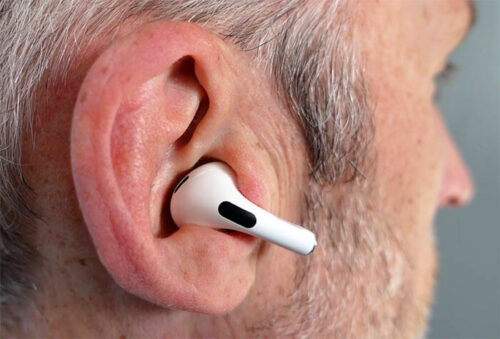
Price: $$$
In my tests, the Apple AirPods Pro 2 were the best noise-cancelling headphones for sleep overall. They have an excellent balance of comfort, audio quality, noise cancellation, and minimal noise leakage. They provide rich, crisp sound that masks external noise and they are a joy to listen to in bed. With four tip sizes and a lightweight design, they are barely noticeable in your ears when lying on your back. They are less practical for side and front sleepers though, unless you have a very soft pillow or are happy using just one earbud. The Bluetooth connection offers six hours of battery life, extendable to 30 hours with the MagSafe case. Voice assistant and call quality are impressive, with touch controls that allow you to change settings in the night. Update: since 2023, the case has a USB-C charging port.
Bose
Noise Cancelling
Headphones 700
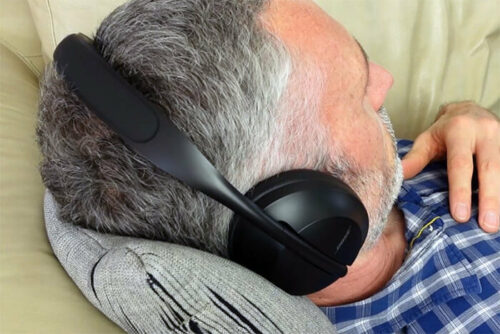
Price: $$$
The Bose Noise Cancelling Headphones 700 were the best on-ear noise-cancelling headphones for sleep in my tests. They are very comfortable for back sleepers and sleeping while travelling, though side and front sleepers naturally won’t use larger headphones like these. Compared to the AirPods Pro 2, their battery life is excellent, lasting up to 20 hours with active noise cancellation. The audio quality, adjustable via an EQ, is excellent. The noise leakage is minimal, which is great if there are others nearby. The sleek design and high-quality materials make them aesthetically pleasing. The voice assistant and touch controls mean you can adjust key settings in the dark without needing your phone or audio device.
Sony WF-1000XM4
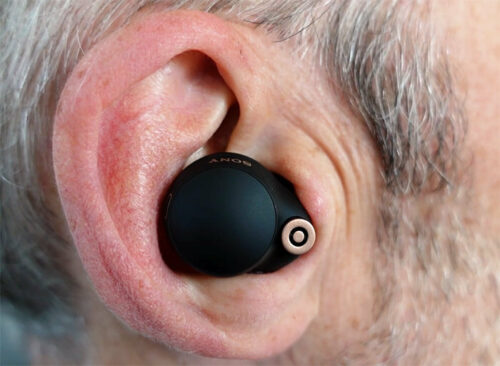
Price: $$$
The Sony WF-1000XM4 earbuds are a good choice for bass lovers looking for a rich audio experience. I found they had noticeably more bass than the other headphones I tested, with an adjustable EQ to boost it or tone it down in the night. The active noise cancellation is very good, and the battery life slightly beats the AirPods Pro 2, with up to eight hours of playback. Their larger design and comfortable memory foam tips, available in three sizes, make them suitable for back sleepers and daily use, but less practical for side sleepers. They have a voice-activated assistant for easy nighttime settings adjustments and touch controls for simple navigation.
AcousticSheep Sleepphones
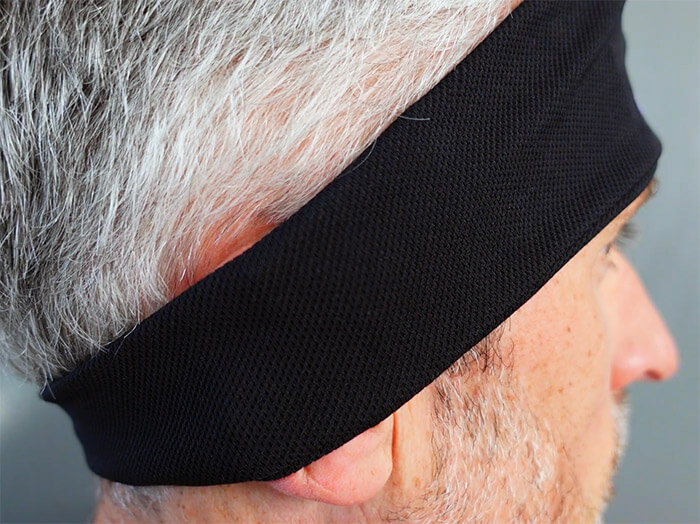
Price: $$
In my tests, the SleepPhones were the best headphones for side sleepers, and arguably the most comfortable headphones to use in bed overall. The main reason is that they have very flat speakers, tucked inside soft padding that feels comfortable around your head. When I lined up all the internal parts of the headband style headphones, these had the flattest and most flexible speakers, as well as the most generous padding in the headband. Like all the headbands, they don’t have active noise cancellation or powerful bass, but they do have clear audio for both music and spoken word. I can easily get over 12 hours of use on a single charge if I keep the volume to a moderate level at night. And there’s a handy built-in control unit for volume and track adjustment. Like all the headbands, it’s slightly fiddly to find the buttons, but I prefer that to my phone screen when I’m half asleep.
Musicozy
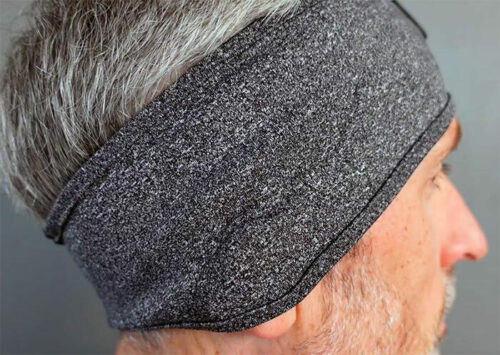
Price: $
The Musicozy headphones were the best lower cost alternative to the SleepPhones in my tests. Although their speakers are slightly thicker, they are still comfortable enough for side sleepers. However, firm pillows and/or sensitive ears might not be the best match for these if you’re a side sleeper. They have solid battery life, lasting up to 10 hours. While they lack active noise cancellation and deliver quite basic audio quality, the noise leakage is minimal, so you should be able to listen to them without disturbing a partner (as long as you don’t turn the volume right up). Despite its practicality for nighttime use, the control module on the forehead might not appeal to style-conscious users.
Cozyphones
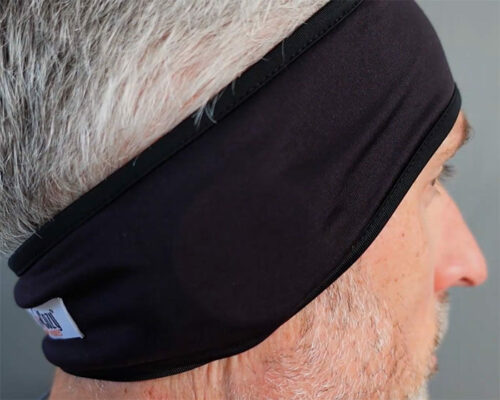
Price: $
The Cozyphones are an affordable wired headband alternative to Bluetooth headphones. I think the only real reason to choose them (for some people) over the SleepPhones or Musicozy is the wired connection. The small speakers are relatively unobtrusive, and they are comfortable in all sleep positions, though there is noticeably less padding in the headband than the SleepPhones. The audio quality is basic with minimal bass, but they provide a straightforward option for quiet bedtime music listening. They lack active noise cancellation, and some sound leakage might be noticed by a bed partner if you turn the volume up.
Maxrock Sleep Headphones
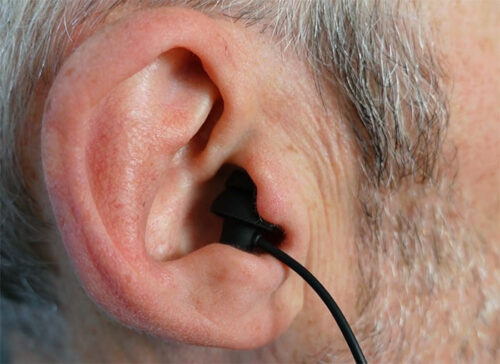
Price: $$
The Maxrock Sleep Headphones resemble regular headphones, but have particularly small and soft earbuds. The tiny earbuds mean you may find you can lie on your side more comfortably than you’ve experienced with standard headphones. With excellent noise isolation, your partner will likely hear minimal sound, if any. However, they fall short in audio quality, particularly in the bass department. Keep in mind that they are wired headphones that lack Bluetooth functionality and active noise cancellation.
Soundcore
Life Q30
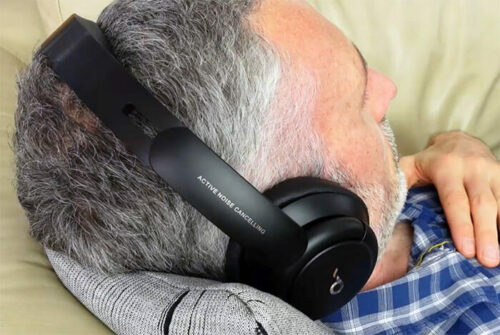
Price: $$
The Soundcore Life Q30 are a solid, budget-friendly alternative to the Bose 700s. They have surprisingly good noise cancellation and noise leakage for the price. The battery life is exceptional with up to 40 hours with active noise cancellation, or 60 hours with music only. The accompanying app has an EQ and a variety of nature sounds for additional sound blockage and relaxation. However, their large cups will limit head movement, even when lying on your back. Like the Bose 700s then, these are good for travel or relaxing on your back, but not practical to sleep with all night long.
Kokoon
Nightbuds
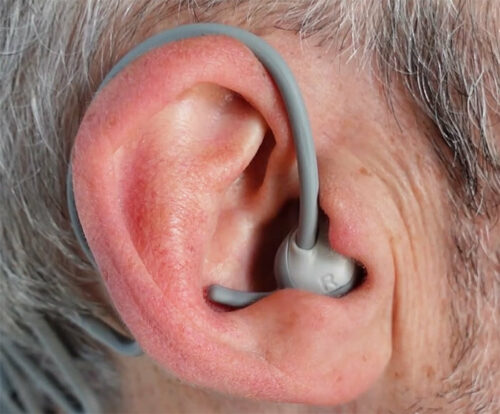
Price: $$$
Designed specifically with sleep in mind, the Kokoon Nightbuds have tiny earbuds that felt noticeably softer than the others I tested, making them a great choice for side sleepers who prefer to use earbuds. Their speakers produce clear sound with minimal leakage, though the maximum volume is quieter than most other headphones I’ve used. While they don’t have active noise cancellation, they compensate with an app that plays a variety of sleep sounds and relaxation talks. A unique feature is their sleep tracking capability, which intelligently fades out the audio as you drift off to sleep – if you have that setting enabled. Kokoon has now entered into partnership with Philips, so you’ll see a rebranding on their website. The tech in the headphones remains the same though.
Dubslabs Bedphones
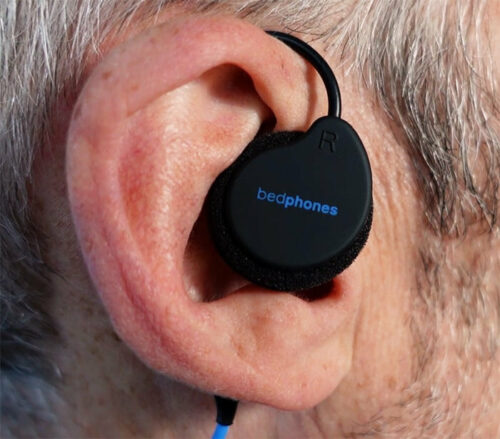
Price: $$
The Dubslabs Bedphones are practical headphones to wear in bed if you need to stay alert to children, alarms, doorbells, or other sounds in your home. The flat, padded speakers hook over your ears rather than going inside or covering them. I find I can hear external sounds much clearer with these than any of the other headphones, especially with the volume kept to a lower level. The speaker quality is clear enough for quiet listening, such as podcasts, and they come in both wired and wireless options. They don’t have active noise cancellation and the design naturally creates some noise leakage. Overall, I think these will suit people who aren’t looking for thumping bass, but just want to play their audio quietly without shutting the world out completely.
Comparison tables
Table 1: Ratings
In table 1 below, I’ve rated the headphones in key performance areas: comfort on your back, comfort on your side, speaker quality, how well they block out other noise in the home, and sound leakage.
Note that they are all comfortable to wear on your back, otherwise I wouldn’t have included them in this article. It’s on your side that their practicality is more noticeable.
The audio quality rating is based on a combination of how clearly I could hear a podcast played quietly, and the quality of the bass, mids, and highs when listening to music more loudly.
How well they block out other noise is based on my video (below) in which I tested how much snoring and music from an adjacent bedroom I could hear when listening to my own music.
Sound leakage is based on how much my partner could hear ambient electronic or classical music at a low-mid volume, and then rock on maximum volume.
The blue text links will take you to Amazon or the company’s website.
| Headphones | Comfort On Your Back | Comfort On your Side | Audio Quality | How Well They Block Other Noise | Sound Leakage |
|---|---|---|---|---|---|
| Apple AirPods Pro 2 | 10 | 7 | 10 | 10 | 9 |
| Bose Noise Cancelling Headphones 700 | 9 | 2 | 10 | 10 | 9 |
| Sony WF-1000XM4 | 9 | 4 | 10 | 10 | 9 |
| SleepPhones | 10 | 9 | 7 | 6 | 8 |
| Musicozy | 10 | 8 | 6 | 6 | 8 |
| Cozyphones | 10 | 8 | 5 | 5 | 5 |
| Maxrock | 9 | 7 | 5 | 5 | 9 |
| Soundcore Life Q30 | 8 | 2 | 7 | 9 | 8 |
| Kokoon Nightbuds | 9 | 9 | 6 | 5 | 9 |
| Dubs Labs BedPhones | 8 | 7 | 6 | 4 | 5 |
Table 2: Key features
In table 2 below, you can see which headphones tick some of the key boxes I look out for when using headphones in bed, as well as the approximate battery life when playing music. Note that the AirPods Pro 2 and Sony have comparably short battery life with active noise cancellation enabled, but both charge quickly in the case.
| Headphones | Wireless | Active Noise Cancellation (ANC) | Side Sleeper Friendly | Battery Life |
|---|---|---|---|---|
| Apple AirPods Pro 2 | ✔ | ✔ | ✔ | – 6 hrs with ANC – Case holds extra 24 hrs |
| Bose Noise Cancelling Headphones 700 | ✔ | ✔ | X | 20 hrs with ANC |
| Sony WF-1000XM4 | ✔ | ✔ | X | – 8 hrs with ANC – Case holds extra 16 hrs |
| SleepPhones | ✔ | X | ✔ | Around 12 hrs |
| Musicozy | ✔ | X | ✔ | Around 12 hrs |
| Cozyphones | X | X | ✔ | Wired |
| Maxrock | X | X | ✔ | Wired |
| Soundcore Life Q30 | ✔ | ✔ | X | 40 hrs with ANC |
| Kokoon Nightbuds | ✔ | X | ✔ | Around 10 hrs |
| Dubs Labs BedPhones | ✔ | X | ✔ | Around 12 hrs |
Table 3: Price snapshot
In table 3, you can compare the prices of the headphones in American dollars and British pounds. If you watch my video, you’ll see that some of the prices are different.
The companies do change them from time to time, so I regularly update the prices in the table to give you an accurate snapshot of the prices on one day. These prices were accurate on March 19, 2024.
| Headphones | US dollars | GP Pounds |
|---|---|---|
| Apple AirPods Pro 2 | $249 | £199 |
| Bose Noise Cancelling Headphones 700 | $379 | £249 |
| Sony WF-1000XM4 | $279 | £259 |
| SleepPhones | $99.95 | £99.95 |
| Musicozy | $20.99 | £15.99 |
| Cozyphones | $24.60 | £24.55 |
| Maxrock | $13.99 | £16.49 |
| Soundcore Life Q30 | $79.99 | £79.99 |
| Kokoon Nightbuds | $285 | £284.99 |
| Dubs Labs BedPhones | $149 | £149 |
Video review
In the video below, I discuss all of the headphones in this article and demonstrate how they feel when using them in bed.
I filmed the video towards the end of 2022. At the time of my last article update, in March 2024, all of the headphones were still available and my views were unchanged.
Video transcript / the headphones in more detail
Below, you’ll find an almost word for word transcript of the video. I’ve only made a few edits to improve readability.
Introduction & how I tested the headphones
It’s one thing to choose headphones for everyday use, but how do you go about finding the best pair of headphones for sleep?
If you sleep on your back or just want to relax for a while you can probably use most headphones, but if you want to block out noise that’s disturbing your sleep, a good set of noise-cancelling headphones might be the way to go.
If you sleep on your side or front, however, many headphones are simply too uncomfortable so you may need to use smaller earbuds, just one earbud, or a headband with padded speakers.
Hi, I’m Ethan Green from Nosleeplessnights.com and in this video I’ll be recommending headphones for different sleep positions, situations, and budgets. As well as talking about some high-end headphones from Sony, Bose and Apple, I’ll also discuss smaller companies that have made headphones specifically for sleep.
As well as using them over the last few years myself personally, I’ve been testing them all side by side during the last couple of weeks to see which ones are the best to use in bed.
I’ve been carefully assessing how comfortable each of the headphones feel when I lie on my side, front, and back. To test the noise cancellation and noise masking, I played snoring through a Bluetooth speaker on the pillow next to me in the range of 50 to 60 decibels, and basically guesstimated how much sound I could hear through the headphones when listening to Sultans of Swing by Dire Straits at 70% volume through a Samsung Galaxy S10e. I then did the same test but with loud electronic music playing in the adjacent bedroom.
I also considered other key factors such as the audio quality, battery life, connection type, price, controls, and additional features. Just to be transparent, I bought all the headphones myself apart from the Kokoon and the BedPhones, which were given to me as a demo. I wasn’t paid or sponsored to do this video, but if you buy any of them using the links in the description below, I might make a commission. So with that said, let’s take a look at the first headphones.
1. Apple Airpods Pro 2
The best noise-cancelling headphones for sleep overall
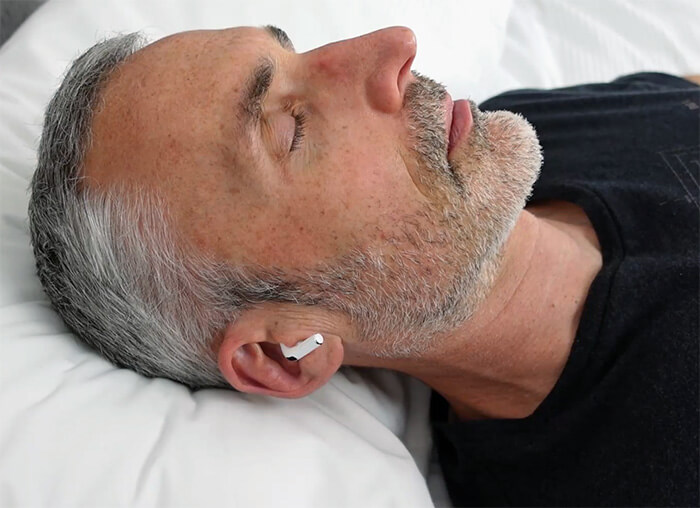
The first three headphones are all superb in their own way so it was very hard for me to decide which to discuss first.
In the end, I decided to start with the Apple Airpods Pro 2 for one key reason: they were the only ones that really blew me away in terms of the audio quality and the active noise cancellation, yet they remain very lightweight and you hardly feel them in your ear when you’re lying on your back. I can even tolerate them on my side with a soft pillow for short periods of time.
The Bose and the Sony coming up also sound fantastic, but they’re just too large to wear on your side.
They come with a reasonable-length lightning to USB-C charging cable, a MagSafe case to charge and store them, and four sets of silicon tips. The extra small tips are new with this model, which will please those with smaller ears.
The case provides up to 30 hours of battery life, and a full charge will last for six hours with active noise cancellation or up to seven without it. If you really need music playing for the entire night though, that might be a touch short.
A great feature of the case is that you can find it with your phone and a little speaker will beep to tell you where it is, which is great if you’re just about to get to bed and you can’t find them.
In the photo below, you can see the Aidpods Pro 2, the MagSafe charging case, the charging cable, and the spare tips.
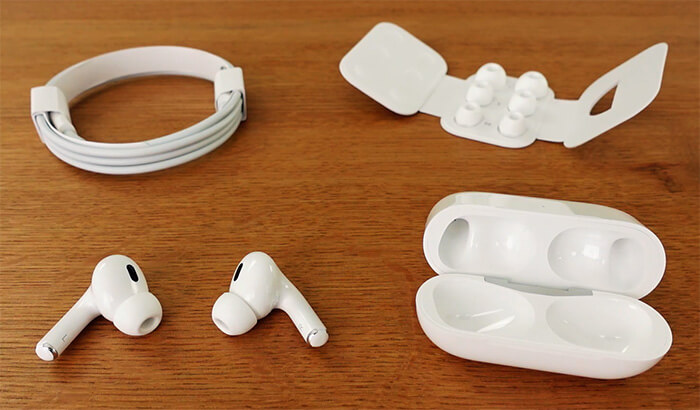
The earbuds themselves are incredibly comfortable to wear on your back, and in daily life of course. You just don’t notice they’re there. As I said, I can lie on my side for a bit too, but not for hours as they are still quite large and the stem is solid.
Talking of the stem, it has touch controls, which is really useful when you’re in bed, as well as voice-activated voice assistant. You can also use it to enter the excellent transparency mode if you need to listen or talk to someone at night.
The sound quality is exceptionally good and I love the neutral sound profile. If you’re not used to audio terminology, neutral is a good thing in this case. They have rich bass, mids, and highs, with both music and speech sounding crisp and natural at low and high volumes.
The active noise cancellation is extremely good too. Apple says their new H2 chip gives twice the noise cancellation as the first generation AirPods Pro and it is very effective. With music on I couldn’t hear any of the snoring or music in the other bedroom, which really surprised me.
The noise leakage is good on low and medium volumes, and most genres at higher volumes too, but if you play electronic music very loudly, for example, your partner may hear some of it.
If you didn’t already know, you can use the Airpods Pro 2 with Android phones as well. You’ll be missing a few features that iPhone users will have, but they still sound incredible right out of the box, and I’d happily use them with an Android phone.
On balance, if you sleep on your back or sleep while traveling, I wouldn’t hesitate in recommending the AirPods Pro 2. Side and front sleepers with sensitive ears will probably find them too uncomfortable, but you can just use one earbud if you want to.
Pros
- Excellent noise cancellation.
- Very comfortable.
- Superb audio quality.
- Minimal sound leakage.
- Good controls and app features.
- Wireless.
Cons
- Not everyone will find them comfortable on their side.
- Shorter battery life than the Bose and Sony (see below).
- Expensive.
Price
I bought mine for £249 in the UK. They currently sell for just under $250 in the US and £199 in the UK.
Update
In 2023, Apple changed the charging port of the case to USB-C, while the case I show in the video had the lightning connector port.
2. Bose Noise Cancelling Headphones 700
The best on-ear noise cancelling headphones for sleeping

If you prefer on-ear headphones to earbuds, if you’d like superb audio performance and very effective noise cancellation, the Bose Noise Cancelling Headphones 700 are very hard to beat.
Yes, you can only wear them while lying on your back, or sitting down when you’re traveling. However, the noise cancellation, the audio performance, and the battery life are all superb. Arguably, the Sony WF-1000XM4 coming up next and the AirPods Pro 2 sound equally good and it’ll come down to personal preference. Where the active noise cancellation is concerned though, personally I think the Bose 700s have the edge when it comes to sleep.
They come with a smart carry case, a fairly short USB-C charging cable, and an audio input cable if you don’t want to use Bluetooth or run out of charge. A full charge will last for up to 20 hours with active noise cancellation and music, which is much longer than the AirPods Pro 2 or the Sony XM4s.
The design is stylish and minimalist, with a sliding adjuster that’s a bit more subtle to use at night than other brands. The inside of the head strap is padded with squidgy silicon which feels very soft, and the padded ear cups with protein leather are also very comfortable to wear for hours in bed on your back or when sleeping on your travels.
In the photo below, you can see the Bose Noise Cancelling Headphones 700, the carry case, charging cable, and audio aux cable.
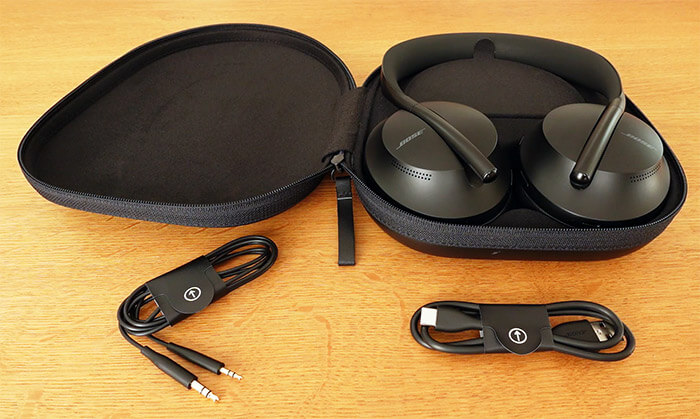
The sound quality is absolutely fantastic, with a neutral sound profile that faithfully reproduces the bass, mids, and highs of your favorite tunes. Listening to Dire Straits, Beethoven, or Orbital was equally good with the 700s.
The controls might divide opinion as there are just three physical buttons, with swipe controls on the right ear cup to adjust the volume and track. It takes some getting used to, but once you do it’s easy enough.
The Bose app has an easy to use equalizer that lets you increase the bass if you find the settings out of the box too neutral for your liking.
The active noise cancellation was, for me, the best of the active noise cancelling headphones I tried, but only just and I think it’s so close between these and the AirPods Pro 2 that it’s probably subjective.
I couldn’t hear the snoring or music in the other bedroom when using the 700s and even without music they cut out a lot of it. You can also adjust the noise cancelling levels from 0 to 10, which is a great feature if you need to listen out for sounds while you’re in bed or out and about.
The noise leakage is very good, with music only escaping at louder volumes, so your partner shouldn’t be bothered if you’re listening to music at a reasonable volume in bed.
Pros
- Arguably the best active noise cancellation.
- Wonderful audio.
- Comfortable on your back.
- Very little noise leakage.
- Good app with an EQ.
- Wireless.
Cons
- Can’t lie on your side.
- Expensive.
Price
I paid just under £350 for mine in the UK. They currently sell for $379 in the US.
3. Sony WF-1000XM4
Noise cancelling headphones with superb audio quality and rich bass
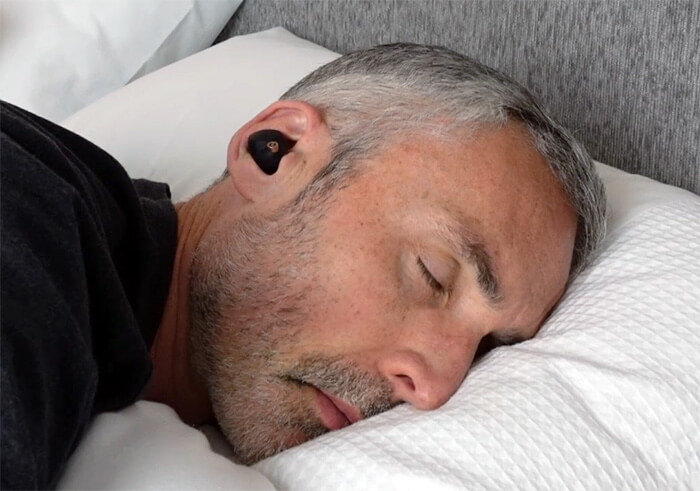
Like the AirPods Pro 2 and the Bose 700s, the Sony WF-1000XM4 (the name is a bit of a mouthful!) also have stellar sound performance and very good active noise cancellation.
They also have richer bass reproduction in my opinion, which fans of Sony’s base that they’re well known for will appreciate. So if you want to fall asleep listening to some electronic music, for example, these are ones to have on your radar.
They come in a MagSafe case, just like the AirPods Pro 2, but you can’t use your phone to find it when it’s lost. There’s a short USB-C charging cable and two additional color-coordinated tip sizes.
The battery life is better than the AirPods Pro 2, giving up to eight hours of active noise cancellation and music, and an extra 16 hour charge stored in the case. And just a five minute charge will give you an hour of play, which is great if you forgot to charge them before going to bed.
The tips have a kind of memory foam squidginess and feel very comfortable in the ear. However, the larger shell makes them more noticeable when you wear them.
The app has a useful feature to test the fit of the ear tips and that’s how I found out that I actually need one medium and one large ear tip. Despite getting the right fit apparently, the active noise cancellation wasn’t quite as good as the AirPods Pro 2 or the Bose 700s for me.
In the photo below, you can see the Sony WF-1000XM4, the MagSafe carry case, charging cable, and additional tip sizes.
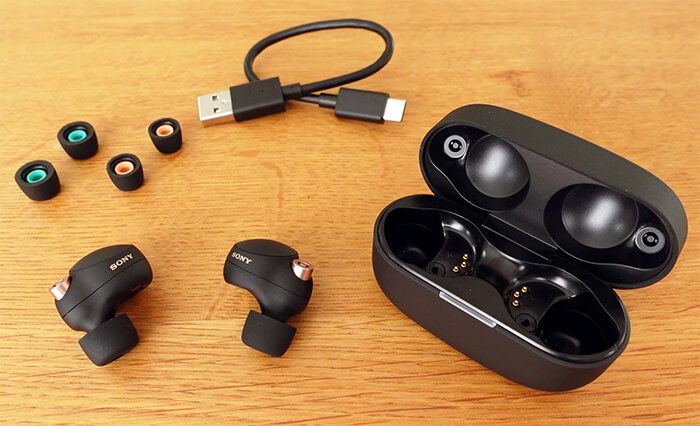
Don’t get me wrong though – the ANC created by Sony’s new integrated V1 processor is still remarkably effective and they managed to cut out nearly all of the snoring and music in the other bedroom in my test with music playing alongside.
The audio quality is stunning with the XM4s. I personally love the bass reproduction as I listen to a lot of electronic music, and listening to ambient music in bed at night feels wonderfully immersive, with solid bass that doesn’t drown out the mids and crystal clear highs.
The noise leakage is reliably good with these, arguably better than the AirPods, so your partner won’t hear much at all unless you’re blasting your ears at night.
The shells have touch sensors to control the volume, track choice, and noise cancellation. There’s also a voice activated voice assistant if you want that. And the Sony app gives you a fun equalizer with lots of presets and the option to adjust it manually.
They’re very comfortable to use when lying on your back or when traveling, and also in daily life. However, they’re just too big to lie on your side comfortably and your pillow is likely to activate the touch button anyway. You can use just one of the earbuds as a side sleeper if you like though.
Pros
- Comfortable tips to wear.
- Superb active noise cancellation.
- Crystal clear sound.
- Incredible bass response.
- Bluetooth connection.
- Google assistant / Alexa integration.
Cons
- Not the best for side sleepers.
- Expensive.
Price
They currently cost a little under $280 in the US, and I bought mine for £190 in the UK when they were on sale.
Interestingly, there’s a good lower cost alternative that don’t have active noise cancellation but do have great audio quality as well, and that’s the Sony WF-C500, which are around $100 in the US.
New model update
The Sony WF-1000XM5 have been released since I filmed my comparison video. I’ve been testing them recently, and the active noise cancellation appears to be a bit better than the XM4 model. That said, I’m not convinced it’s so much better that it’s worth paying the extra if you can still find the XM4 for a lower price.
4. SleepPhones
The best headphones for side and front sleepers
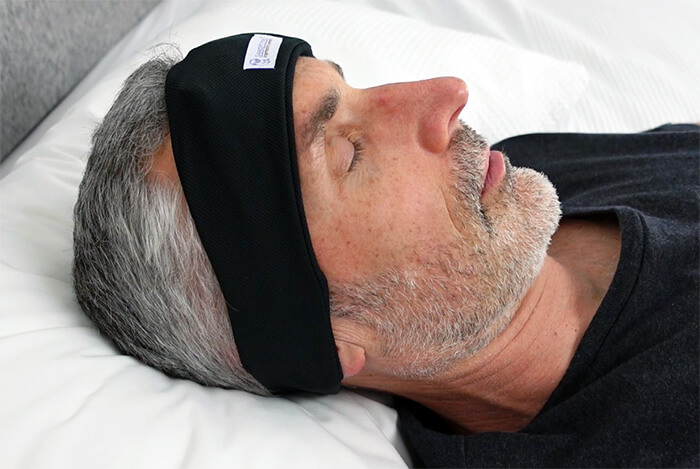
The SleepPhones were designed specifically to be used in bed and are particularly good for side and front sleepers. There’s actually a growing number of this headband style of headphones and I’ll be looking at a few in this video/article, but the SleepPhones are my favorites for three key reasons.
Firstly, they have the flattest speakers and the most comfortable padding. Secondly, the speaker quality is better than the others. And thirdly, the sound leakage isn’t too bad either, so if your partner’s in bed they’re not going to hear too much of your music.
In the photo below, I’ve removed the components to wash the headband. You can see how flat and padded the speakers are.
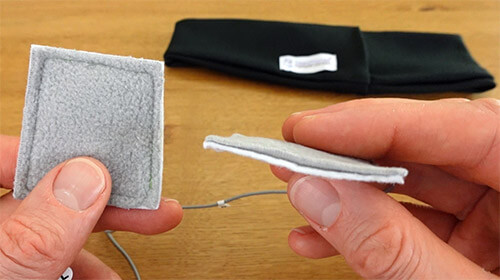
They come with a good length micro-USB charging cable, but no carry case. They take four hours to charge and I find a full charge will last well over 12 hours. It’s a bit fiddly to remove the control module to plug in the charging cable, but they do have a more expensive version with an easier induction charging method.
The control module can be used to play and pause music and change the volume and track. You do need to feel through the fabric to find the tiny buttons though, which can be a bit fiddly.
The headband is breathable and stretchy thanks to the polyester and spandex material, and feels very comfortable to wear. The speakers are flat and encased in soft padded material. With the additional padding of the headband itself, they don’t put too much pressure on your ears and I find I can lie on my side or front for longer than any of the other headphones.
Below, you can see the speakers of the three headbands in this article. From left to right: SleepPhones, CozyPhones, and Musicozy.
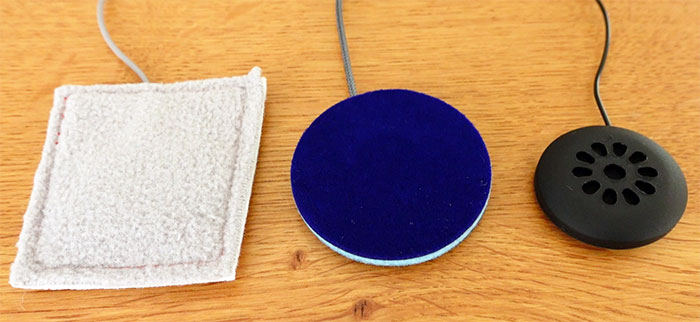
The audio quality is good for this style of headphones, with a more neutral sound signature than the lower cost headbands coming up next. They don’t produce a lot of bass, but there’s enough to enjoy music quietly in bed without feeling like something is missing. In contrast, the budget headbands are distinctly lacking in bass and mids, sounding quite thin with the focus on the highs.
Like all the headbands, they don’t have active noise cancellation, but the padding of the material and the reasonable speakers did help block out some of the snoring and music playing next door.
The noise isolation is fairly good too and your partner shouldn’t hear much unless you turn the volume right up, and even then it’ll be relatively quiet compared to the other headbands and many of the standard headphones.
On balance, none of the headbands can compete with the audio quality or style of the high-end Bose, Apple, or Sony, but that’s not what they were made for.
They sound good enough for some quiet bedtime listening and when you’re lying on your side they’re much more comfortable than the majority of in-ear and over-ear headphones. And the SleepPhones are the best of the bunch when it comes to comfort on your side and overall design quality.
Pros
- Great for back, front, and side sleepers.
- Clear sound.
- Bluetooth connection.
- Good noise isolation.
- 12 hour battery life.
Cons
- No active noise cancellation.
- Underwhelming bass.
- Lower maximum volume.
Price
They cost just under $100, so they are the most expensive of the headband styles. If that’s out of your budget, take a look at the Musicozy coming up next.
Read my full Sleepphones review to find out more.
5. Musicozy
The best low-cost headband style of sleep headphones
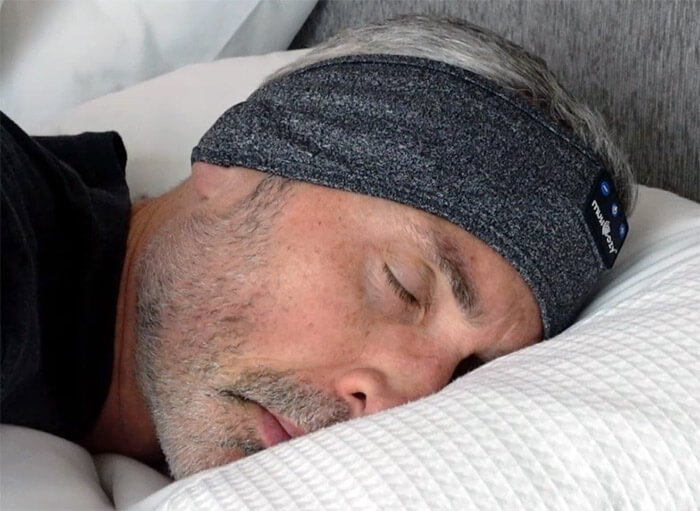
The Musicozy are one of the best low-cost alternatives to the SleepPhones. There are actually a lot of these headband styles floating around on Amazon at the moment, many of which look very similar. To find out more, I got three new ones and although they do have a lot in common, there are also some differences in the design and the speaker quality.
The three I bought were the Musicozy, the Hanpure, and the Fulext sleep headphones. The material is visually similar, as is the control module that sits on the forehead when you wear them. There are a couple of reasons I prefer the Musicozy to the others though.
Firstly, there’s a small gap in the fabric where you can connect the micro-USB cable to the control module to charge it, which is more convenient than the design the other two have. Once it’s charged, it will last for eight to ten hours, which is a decent amount of time.
The second reason is that the speakers are noticeably better. The Hanpure sound very cheap and thin, the Fulext are way too quiet and unnatural, and both have virtually no bass. The Musicozy don’t exactly have faithful sound reproduction either, but it’s noticeably better. At the end of the day though, none of the budget headbands will reproduce your favorite songs accurately, so it’s a matter of choosing the best of the bunch.
In the photo below, you can see the three low-cost headband style of sleep headphones I tested. From left to right: Hanpure, Musicozy, Fulext.
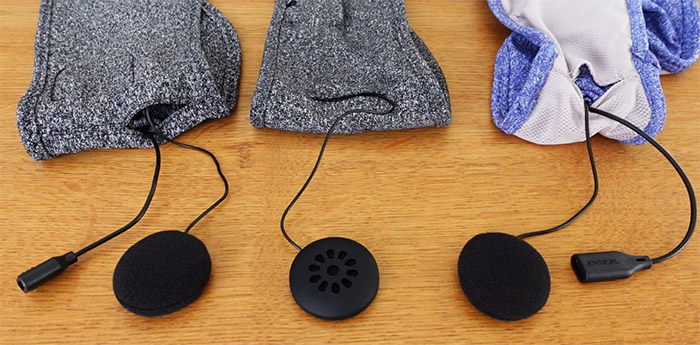
Importantly, the noise leakage was better with the Musicozy too, so your partner shouldn’t hear much of your music unless you turn it right up. There’s no active noise cancellation and there’s not enough padding to block out external noise, so I heard all of the snoring and music in the other bedroom during testing.
They are comfortable to wear in bed though, and I could use them when lying on my side for extended periods of time. Having said that, the speakers are thicker and less padded than the SleepPhones, so I don’t think you can wear them on your side for the whole night.
Overall, these are low cost headbands that might be all you need if you just want a comfortable way to listen to music or podcasts quietly in bed. Just don’t have high expectations of the audio quality and be willing to have an obvious control panel on your forehead that turns you into a fabric android.
Pros
- Good for side sleepers.
- Wireless.
- Clear enough audio.
- Good noise isolation.
- Low price.
Cons
- Buttons on your forehead.
- No active noise cancellation.
- Look cheaply manufactured.
Price
The price on Amazon seems to change regularly for these headphones, but they usually cost under $20 in the US and under £20 in the UK.
6. Cozyphones
Sleep headband with wired connection instead of Bluetooth
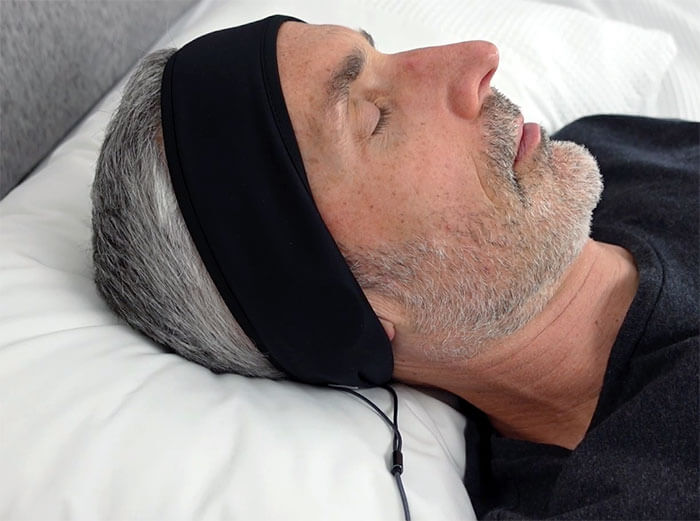
If you like the idea of the headband style of headphones, but you don’t want to connect via Bluetooth, then the Cozyphones might be ones to try as they connect with a cable and 3.5mm jack instead.
For the very low price, it’s understandable that the audio quality isn’t the best, but at least the flat speakers make them very comfortable to use on your side.
They come with a little carry bag and there are different sizes and styles to choose from. Mine is made from lycra on the outside, with a mesh inside. They feel soft against the skin and the headband has some give to help it sit on your head nicely. The cable is very long at 52 inches and will easily stretch to a phone on a nightstand.
The speakers are flat and can be removed so you can wash the headband. Removing and replacing them is much quicker than the SleepPhones or Musicozy. That’s because they slide around inside the headband easier though, which also means they slide out of place easily and need adjusting from time to time.
Below, you can see the CozyPhones, the carry bag, and the long cable to connect to your phone or other audio device.
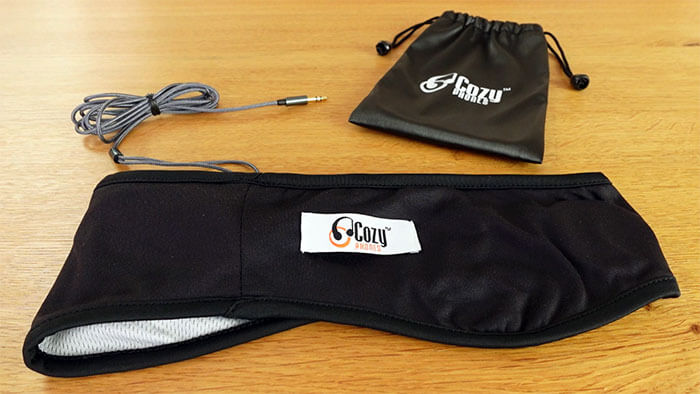
As with all wired headphones, if you use them nightly it’s possible they’ll break eventually. How soon exactly will depend on how much you lie on them and put force on the connection between the wire and the speaker.
They are comfortable to use on your back, front or side because of the flat speakers. However, I still think the SleepPhones are better padded and therefore more comfortable.
The audio quality is very basic. There’s very little bass or mids, with only the highs being clear. So they’re fine for spoken word or listening to some music quietly, such as classical piano, but not ideal if you like a neutral sound profile or music with a lot of bass.
The lack of bass and low volume meant that they did a very poor job of masking the sound of snoring or music in the adjacent bedroom. Despite the low volume, there’s quite a lot of sound leakage so a partner will hear your music, particularly the bright highs.
Overall, the Cozyphones will suit one particular need: if you want a headband with a wired connection instead of Bluetooth.
Pros
- Good for side sleepers.
- Cable for those who don’t like Bluetooth.
- Low cost.
Cons
- No active noise cancellation.
- Lacks bass and volume.
- Poor sound isolation.
Price
One of the main plus points is the low price. They currently cost under $25 in the US and £25 in the UK.
7. Maxrock / Sound Magic E11 / Sennheiser CX-300
The best wired earbuds to use in bed, with small tips and good sound leakage
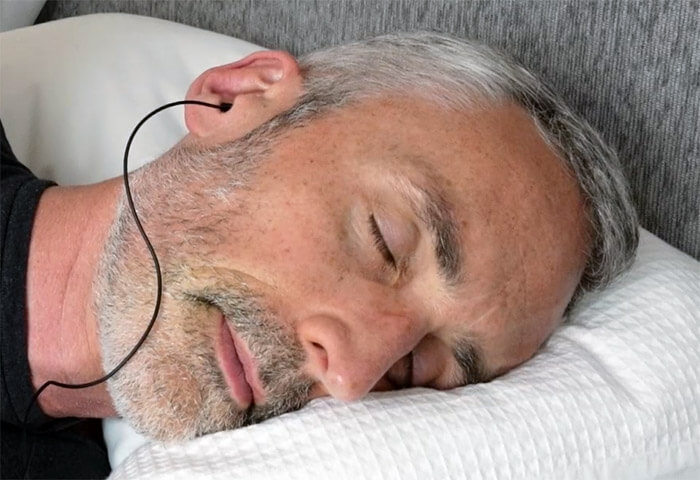
If you’d rather use wired earbuds instead of connecting via Bluetooth then there’s a huge range to choose from. In theory, you can use any you like, especially if you’re just going to relax in bed listening to music before going to sleep or if you’re going to sleep on your back.
However, if you’re going to spend any time on your side, if you need to block out some noise, or if you want to reduce how much sound your partner hears, then the choice starts to narrow.
This was actually one of the hardest categories for me to pinpoint a favorite, so I’m going to talk about three different ones briefly so you can see how they compare.
Below, you can see the three wired headphones. From left to right: Sennheiser CX-300, Maxrock, Sound Magic E11.

Maxrock Sleep Headphones
The Maxrock have the smallest earbuds, even though they don’t come with any changeable tips. They’re very comfortable to wear on your side and put much less pressure on your ears than the other two. The noise isolation is great as well and your partner will hear very little.
The audio quality is underwhelming though, with hardly any bass of note and the highs are much more noticeable than the mids. They also don’t block out much external noise.
Sound Magic E11
The Sound Magic E11 are the longest of the earbuds and aren’t suitable for lying on your side in my experience. They are comfy on your back though.
They have a neutral sound profile, with reasonable bass and clear mids and highs. They didn’t block out much of the snoring or external music in my tests, but the noise isolation is fantastic. If you share your bed, your partner will only hear your music on maximum volume, and even then, not much of it at all.
Sennheiser CX-300
I like the shape of the Sennheiser CX-300 and found I could wear them on my side for longer than the Sound Magic. They have the best bass and mids of the three wired earbuds and the best overall audio quality.
They do block out a bit of snoring and music, though not all by any means. The noise leakage isn’t great though and a partner will hear your music.
On balance then, I’d pick the Maxrock for comfort, especially if you’re a side sleeper. The Sound Magic for the noise isolation, or the Sennheiser for the best sound profile.
All three cost under $70 dollars in the US or £50 in the UK. The relatively low price was one of the reasons I chose these three in the wired earbud category.
8. Soundcore Life Q30
The best low-cost on-ear noise cancelling headphones, with sleep sounds on the app
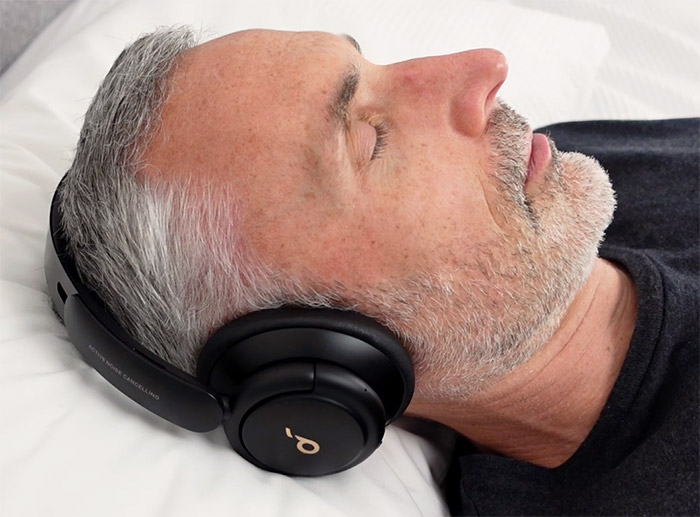
The Soundcore Life Q30 have three main things going for them as sleep headphones. Firstly, as on-ear noise-cancelling headphones, they’re a surprisingly good low-cost alternative to the Bose 700s. Secondly, the app has a specific sleep section, with nature sounds and also a timer. And thirdly, they have superb battery life with up to 40 hours of play.
They come with a smart carry case, a 3.5mm auxiliary cable to listen wired, and a short USB-C cable to charge them. Charging is exceptionally fast, with five minutes giving you four hours of play time. And the 40 hours of charge they hold extends to around 60 hours without noise cancellation.
The ear cups are larger than the Bose 700s. They are very comfortable though, with memory foam interior and protein leather exterior.
The buttons on the side make it easy to change the track and volume or turn the noise cancellation off and on. You can cover the right cup to change modes, which is great if you want to quickly enter transparency mode if you need to listen out for something in your home.
The app gives you three noise cancellation modes and I find the noise cancellation is very impressive for this price bracket, especially for removing lower frequencies. They did a really good job of quietening the snoring and the music in the adjacent bedroom I played on my speaker. And when I turned music on, I couldn’t hear the music next door or the snoring at all.
Below, you can see the Soundcore Life Q30 headphones, carry case, charging cable, and audio aux cable.
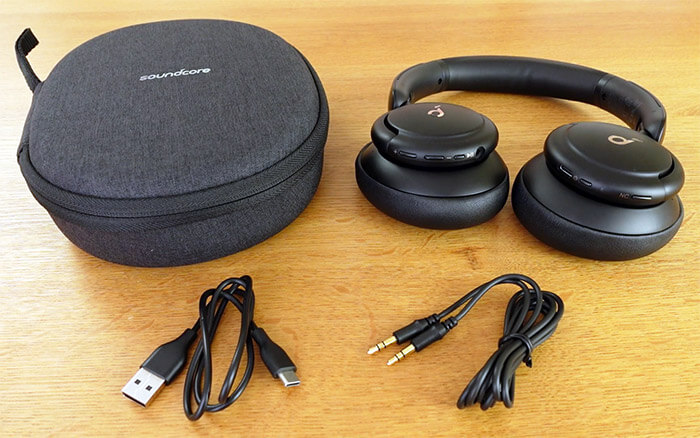
I also like that the app has an EQ and you can boost the bass significantly. The audio quality is decent, with loud maximum volume and clear speech on low volumes. But I find the bass does sometimes overwhelm and muddy the mids and highs.
While these sound much better than all of the headbands and wired headphones, my top three Bluetooth headphones all have a more pleasing sound signature.
The app also gives you the option to mix 11 ambient sounds, such as rain, wind, ocean, fan, or a train. You can set a timer too, but if you forget to turn your music off first I find it jumps back to that when the timer is up, which seems like a flaw to me.
They’re comfortable to use on your back in bed, but the size does restrict your side to side head movement more than the Bose 700s. They really do keep your head locked in place, and on your side or front, they’re obviously unusable.
The noise leakage is pretty good, with only music on louder volumes getting through. If you listen to quieter music or spoken word, your partner won’t hear anything. On balance, if you’d like some on-ear noise-cancelling headphones and have a lower budget, the Soundcore Life Q30 are ones to consider.
Pros
- Superb battery life.
- Decent noise cancellation.
- Comfortable on your back.
- Good audio.
- App with an EQ and relaxing nature sounds you can mix.
Cons
- Can’t use on your side.
- Large cups restrict head movement a bit when on your back.
- Bass can be too much.
Price
They currently cost £79.99 in the UK and $79.99 in the US, which I think is very reasonable for what they offer.
9. Kokoon Nightbuds
The most comfortable ear tips, sleep sounds on an app, and sleep tracking built in
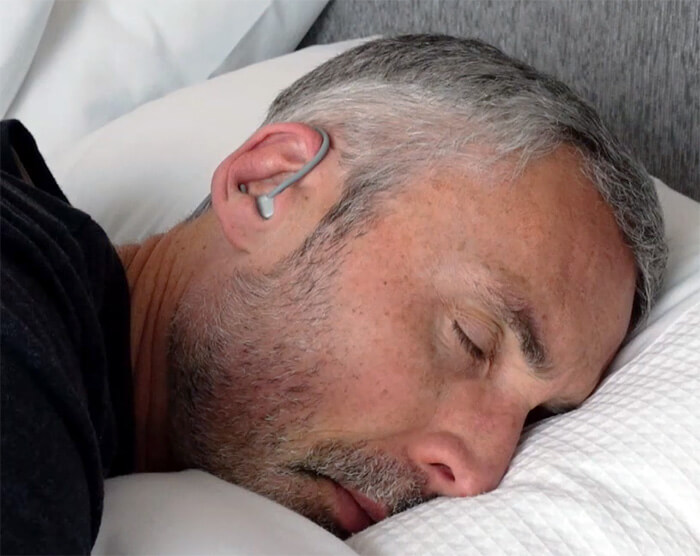
The Kokoon Nightbuds are my top pick of wireless earbuds that were specifically designed for sleep for two important reasons. Firstly, they’re very comfortable to use when lying on your side.
Secondly, as well as having a library on the app with sleep sounds, nature sounds, and meditations, you can also stream your own music. And that point alone made me choose them over the Boss Sleepbuds, the Amazfit Zenbuds, and the Quieton 3, none of which let you stream your own music.
They come with a smart carry case that’s about the size of a pencil case, a short USB charging cable, and different size tips. I really like the way the tips are designed. They have a small silicon tip and a wing that’s much flatter and smaller than the large earbuds like the Sony and also the Airpods Pro 2. I also like how they provide other size tips and wings so you can get the best fit for your ears.
Each side is connected to a control unit, with a flexible wire that has a concertina shape. The wire sits over your ear and the curved control hugs the back of your neck. It feels a little awkward at first, but you get used to it and it’s preferable to having loose cable in bed.
Below, you can see the Kokoon Nightbuds, the spare tips and wings, carry case, and charging cable.
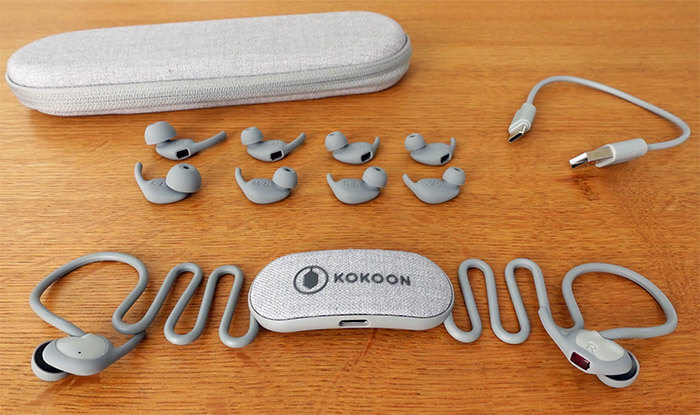
They connect to your phone via Bluetooth with no option to use them wired. A full charge will get you 10 plus hours of play, depending on how you use them.
The main controls are all on the companion app. You can use it to play a range of relaxing nature sounds, meditations, and storyscapes. I like the body scan, for example, which reminds me of the Calm app. I hope they grow the library over time though, as it could do with more choice.
A really useful feature is the audio fade out. The Kokoon will detect when you fall asleep and then fade your audio or the sleep sounds out over a time of your choice, if you want that feature.
They’re very comfortable to wear on my back, front or side. In fact, other than the headbands, I’d say they’re the most comfortable option if you’re sleeping on your side.
As comfortable as they are, they aren’t going to wow you with the audio quality though. The mids and highs are nice and clear, but they have very little bass, and the maximum volume really isn’t very maximum.
There’s no noise cancellation and the sound masking is poor. I could hear all the snoring and music from the other bedroom, even when listening to music. The sound leakage is good though and your partner will only hear your music with the volume turned right up.
Overall, I think the Kokoon are worth considering if you’d like to combine sleep sounds and your own audio. You can even do exactly that – layer nature sounds over the top of your music, which is a unique feature. The earbuds are among the most comfortable I’ve ever used in bed too, as long as you can tolerate the wire and control unit around your head.
Pros
- Very comfortable earbuds, even for side sleepers.
- Excellent companion app, with relaxing talks and sounds.
- Automatic audio fade out when you fall asleep.
- Sleep tracking built in.
Cons
- Control unit on the back of your neck.
- Low volume.
- Don’t mask external noise.
- Expensive.
Price
The price could be a sticking point for some people. They currently cost around $285 in the US and £285 in the UK. I think that’s quite pricey for the audio quality, despite all the clever extra features they offer.
Branding update
Kokoon is now in partnership with Philips. They have since rebranded the headphones as Philips Sleep Headphones With Kokoon. So if you decide to visit their website, you’ll notice the name change. I asked Kokoon about this, and they told me the tech of the headphones remains the same as when I filmed them.
10. Dubs Labs Bedphones
Ideal if you need to listen out for children or alarms
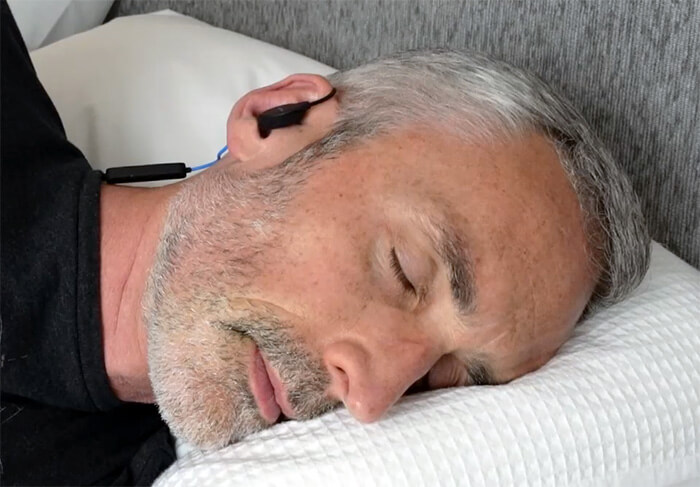
As you can probably guess from the name, the Bedphones, made by the company Dubs Labs, were specifically designed for sleep. They’re particularly good if you need to listen out for kids in the home or perhaps alarms as well. However, just don’t expect any thumping bass or active noise cancellation with these.
The Bedphones connect via Bluetooth and come with a short charging cable. A full charge lasts around 12 hours, which is great.
Each speaker is small, flat, and encased in some foam padding. They hook over your ears with a flexible wire, which is a bit fiddly until you get used to it. There’s a thin cable connecting the two speakers to be aware of, but at least there’s a useful inline control for play, pause, volume, and track choice.
Below, you can see the Dubs Labs Bedphones, carry case, charging cable, and spare foam covers for the speakers.
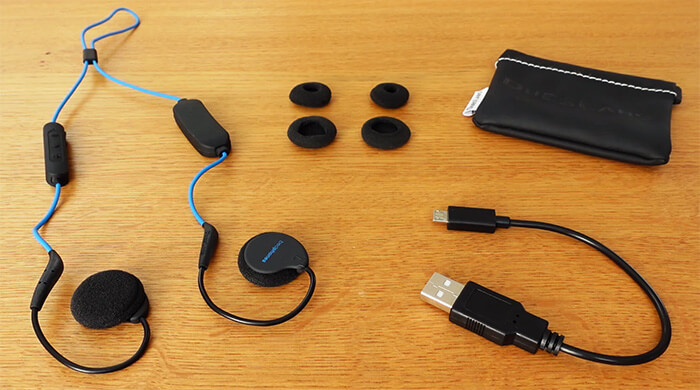
Music and speech come through quite clearly so you can enjoy your music or podcasts at a lower volume. They don’t produce a lot of bass though, unless you lie on your side and push one speaker into your ear.
I find them very comfortable to use on my back and they’re fine on your side or front for a while as well, but after a while you might find the fairly stiff wire around the ear becomes uncomfortable.
There’s no active noise cancellation, and since they don’t completely cover your ear canals, they were the worst for masking the sound of snoring and music next door in my tests.
Another problem is the noise leakage. If you sleep with someone, they will hear your music even on lower volumes. There are better Bluetooth speakers in this price range, so I think these are best suited to parents or those with alarms they can’t afford to miss.
Pros
- Clear speaker quality.
- Wireless.
- Don’t overheat.
- Can still hear people and alarms.
- Inline volume control.
Cons
- Not ideal for sleeping on your side.
- No active noise cancellation.
- Lack bass.
Price
The Bluetooth version costs $149 and you can get a wired version for $89.
Find out more in my Dubslabs review.
Where else to buy the headphones
I bought the headphones in this article either on Amazon or the company websites, so I’ve included those links as I know what you get when you order from those sites.
Being headphones, some of them are widely available though. For example, in the US could try Walmart, Best Buy, and Target for some of the bigger brand names like Sony, Bose, and Apple. In the UK, you might find them in places such as Argos, Currys, and John Lewes.
You’ll also find many of them on eBay. My advice would be to check the ratings of the seller carefully to reduce the chance the headphones have been damaged and then sold on.
Headphones are also worth keeping an eye out for during seasonal sales. You’ll often find good discounts at these key times, such as Black Friday, Amazon Prime Day, New Year’s, or back to school time in late August and early September.

